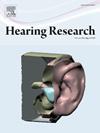Auditory sensitivity in the great evening bat (Ia io): Insights from auditory brainstem response
IF 2.5
2区 医学
Q1 AUDIOLOGY & SPEECH-LANGUAGE PATHOLOGY
引用次数: 0
Abstract
The great evening bat (Ia io), a large frequency-modulating (FM) bat species in the Vespertilionidae family, may exhibit unique auditory adaptations that support its bird-predatory behavior. In this study, we employed auditory brainstem response (ABR) measurements to evaluate the auditory sensitivity of five adult male I. io across a 2 to 80 kHz frequency range. The results showed the most sensitive auditory threshold appears at 24–28 kHz (range 24 to 32 kHz for individual bats), aligning with the species’ peak frequency of echolocation calls, enhancing large prey detection and localization. ABRs identify five distinct wave peaks (P1–P5) at high sound pressure levels, with the largest amplitude peak observed for P4. Furthermore, I. io has lower auditory thresholds across higher frequencies than most other FM bats. These findings suggest I. io has a broad auditory range that may facilitate adaptive flexibility in varied ecological settings.
大夜蝠的听觉敏感性:来自听觉脑干反应的见解
大夜蝠(Ia io)是大夜蝠科的一种大型调频(FM)蝙蝠,它可能表现出独特的听觉适应能力,这支持了它的鸟类捕食行为。在这项研究中,我们采用听觉脑干反应(ABR)测量来评估5名成年男性io在2至80 kHz频率范围内的听觉敏感性。结果表明,最敏感的听觉阈值出现在24 - 28 kHz(单个蝙蝠的范围为24 - 32 kHz),与该物种回声定位呼叫的峰值频率一致,增强了大型猎物的探测和定位。ABRs在高声压级下识别出p5 - p1五个不同的波峰,其中P4的振幅峰值最大。此外,I. io在更高频率上的听觉阈值比大多数其他调频蝙蝠低。这些发现表明,io具有广泛的听觉范围,可以促进在各种生态环境中的适应性灵活性。
本文章由计算机程序翻译,如有差异,请以英文原文为准。
求助全文
约1分钟内获得全文
求助全文
来源期刊

Hearing Research
医学-耳鼻喉科学
CiteScore
5.30
自引率
14.30%
发文量
163
审稿时长
75 days
期刊介绍:
The aim of the journal is to provide a forum for papers concerned with basic peripheral and central auditory mechanisms. Emphasis is on experimental and clinical studies, but theoretical and methodological papers will also be considered. The journal publishes original research papers, review and mini- review articles, rapid communications, method/protocol and perspective articles.
Papers submitted should deal with auditory anatomy, physiology, psychophysics, imaging, modeling and behavioural studies in animals and humans, as well as hearing aids and cochlear implants. Papers dealing with the vestibular system are also considered for publication. Papers on comparative aspects of hearing and on effects of drugs and environmental contaminants on hearing function will also be considered. Clinical papers will be accepted when they contribute to the understanding of normal and pathological hearing functions.
 求助内容:
求助内容: 应助结果提醒方式:
应助结果提醒方式:


